In 1901, the United States’ first speed limit laws
were introduced in Connecticut, allowing 12 miles per hour in town and 15
MPH in the country. Ever since then, drivers have been trying to strike a
balance between the legal posted speed and the speed at which they can safely
travel without getting a ticket. Don’t even try to deny it – I doubt that there
is a single person reading this review that maintains the legal speed limit
100% of the time. But that’s okay, I am not about to start casting stones because I
am just as guilty.
Yes, I have been guilty of speeding on many occasions. Sometimes it just happens,
like when I am driving down West Beauregard, a four-lane street here in San
Angelo that seems to have as many speed limit changes as it has street signs.
But sometimes I’ll do it consciously, like when I am on the interstate and the
speed limit is 75 but 80 just "feels" better". Whatever the situation happens
to be, the fact of the matter is that if I am caught speeding, then I will more
than likely get a ticket. If I get a ticket, and I don’t have the spare time to
attend a defensive driving course or the spare money on top of the price of the
ticket to pay for a deferred adjudication, then my insurance rate will go
up. Since it is unrealistic to think that I will never speed, it is therefore in
my best interest not to be caught when doing so.
I should probably mention that I have not had a ticket in almost four years (knock
on wood!), and before that I hadn’t had a ticket in over ten. While I would
like to credit my better than average record on always driving at or under the
posted speed limit, the fact of the matter is that I haven’t received a ticket
in so long because I am a firm believer in using a good radar detector. In fact,
the one ticket that I did receive occurred on the interstate when I had
forgotten to plug my detector back in after a pit stop. My detector was sitting
useless in the glove-box, while I was driving unprotected. Grrrr…
Until now, the only type of radar detectors that I have owned have been those
that are considered "portable models" – because they are easily installed and
removed from one vehicle to another. The closest I have come to what might be
considered an "installed system" has been when a portable radar detector’s power
cord was hard wired into my vehicle’s fuse box – with the loose power cord
carefully hidden behind the windshield’s trim. This is usually what I will do
when there is a particular detector that I use all the time in one vehicle, and it generally works pretty well. The "stealthiest system" I ever had
was the 1986 BEL radar detector that fit over my car’s rear view mirror, and
which combined a radar detector with its own built-in rear view mirror. This
device was a complete piece of junk and it wasn’t long after the return period
had passed when I realized that I had been suckered out of my money.
In 1988, my brother Mark had a very expensive "hidden" radar detector
system installed in his Chevrolet dually pickup truck. I can’t remember what
brand it was, but I do remember rolling my eyes at him because it looked like he
had inserted some bright and colorful "Knight
Rider" contraption into his dashboard! I understood the part about there
being a sensor in the front of his truck that was wired through the firewall to
the in-cab display, but I was having trouble with the fact that he had had to modify
his dash to accommodate an equalizer-sized display unit with buttons and a row
of no less than ten oscillating yellow, green and red lights. Depending
on whether or not the detector was picking up a radar signal, the lights would glow
corresponding colors and a faint blipping would sound. Tacky, tacky…
"Tell me again how this is better than just putting a radar detector on your
windshield?" I asked.
"Well for one thing, no one is going to see my radar detector from
outside the truck, so they aren’t going to be tempted to break in and steal it."
"Yah, but if I was a cop I would pull you over just for having party lights
in your truck!"
He did have a point, because I had already had two different
convertible tops slashed before learning to always remove my radar
detector and place it either under the driver’s seat or in the glove box when it
wasn’t being used. But his detector looked cheesy – even by 1989
standards – like a Christmas Tree full of cha-cha lights blinking merrily. If I
could put the glowing lights out of mind for a moment, then I could admit that I
was more than slightly intrigued by the idea of a radar detector that was
permanently installed and therefore always ready to operate, never forgotten and
yes – harder to steal. I just wasn’t sure about cutting up my vehicle in order
to install one.
So lets fast forward to 2005. Built-in radar and laser systems are no longer
clunky dashboard installed units that require the defacing of a person’s second
largest investment next to their home. Instead, they have become remarkably
discreet, utilizing small LED lights either mounted into the vehicle’s dashboard
or dial cluster, as well as other unobvious methods of immediately getting the
driver’s attention.
In the last ten years it has become de rigueur that certain high end sports
cars come from the dealership with an optional built-in radar and laser system
installed. However, most average consumers may not be aware that they too can
have the same built-in radar and laser systems as those typically installed in
Ferraris, Porsches, Lamborghinis and Vipers. There are now three companies, of which I am
aware, that offer custom installed radar and laser detection systems:
Beltronics (BEL),
Escort, and
K40. Generally these systems are offered either
through a particular car dealership or through certain auto electronics stores
which offer custom installation. Because these are built-in systems which
require working with wiring schematics, dismantling the vehicle’s dash, drilling
into or through metal and possibly fabricating a custom mount depending on the
desired end installation, they are not generally sold for non-professional
installation.
Today I am going to take a look at the
CALIBRE Remote Bluetooth Enabled
Radar And Laser Protection System which is the latest offering from
K40, a company already well known among
automobile enthusiasts for their
built-in radar and laser detection systems and more recently known for their
portable
RD850 detector which I reviewed last year. Perhaps you caught the
"Bluetooth" portion of the CALIBRE’s name? What makes the CALIBRE different from
every other built- in system offered is the fact that other than the wires powering each
component, there are no wires used to connect each part of the system to the
other. Instead, they all communicate via Bluetooth with the Interior
Bluetooth Network Module. In layman’s
terms, this means that the installed CALIBRE system does not require holes to be drilled through the
firewall of the vehicle. There are no wires running from the front of the
vehicle to the rear and
through the cabin. If the vehicle should ever be sold – the system could
actually be removed, though depending on how integrated with the vehicle’s
interior the installation was, it might not
necessarily be an easy thing to do.
When I was originally contacted about doing a review on the CALIBRE, I had a
different vehicle in mind for its installation. But in what I now see as
an act of perfect symmetry to the 1989 version installed in my brother’s truck, this
built-in system would be installed in my ranch truck.
Grant, my contact at K40, offered to send me the complete CALIBRE DL system, which
includes front and rear Radar Receivers, two warning LEDs, an Interior Bluetooth
Network Module, an under-dash mounted speaker, a remote control, the necessary
installation parts kit as well as optional
front Laser Defuser. With the understanding that this review would require a
professional custom installation on my vehicle, Grant said that he would not
expect the equipment’s return. Wow – this could turn out to be a really
great deal for me – provided the K40 CALIBRE system was as good as its hype. If not…well then, I
would have an inadequate system installed in my truck that I might or might not
want to bother having uninstalled. It could go either way…
Since I knew that the Sheriff’s Department in my city did not use Laser, and
as I later learned the police department does have it – but it is a carefully
guarded commodity, Grant knew going into the review that I would probably not be able to test
the Radar Defuser in action. Therefore I will briefly touch upon its features
later in this review.
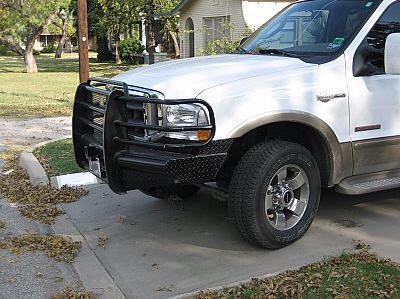
The first step of completing this review was the actual installation on my
truck. I don’t think that Grant expected all the extra metal when he told me about how the CALIBRE could be mounted invisibly
behind the grill. Seeing as the Radar Receivers can be
mounted behind plastic, rubber or fiberglass up to
¼" thick, but they can’t be mounted completely behind metal or chromed
plastic, I decided that to be safe, on my particular install the front
and rear receiver boxes would have to be hidden in plain site. On the typical
car, the Laser Defuser could be mounted in an assortment of areas, all either
completely hidden from view or nearly so.
Since my truck’s grill is already set up to accept a portable winch…
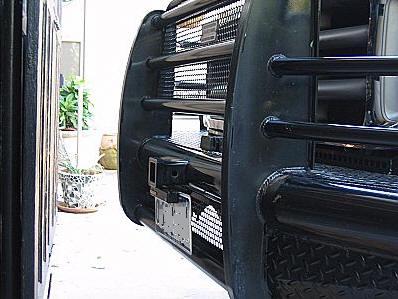
…we just mounted the weatherproof receiver so that it would appear to be
the plug for the winch cable.
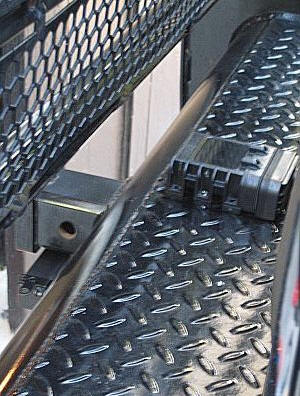
As you can see in this picture, the black box blends in with the black grill,
and no one is the wiser. I simply had to remove the silver K40 FCC ID sticker
that was on the top of
the receiver. The long black box hovering above
the front license plate is the Laser Defuser.
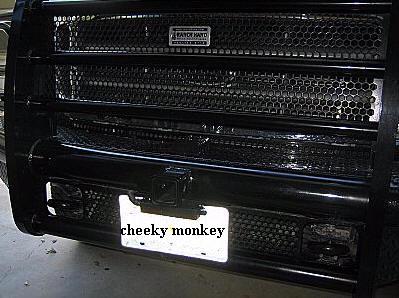
Just for reference, here is a gray winch receiver mounted on another one of
our ranch trucks. Who’s to say that they don’t come in black now? ;0)
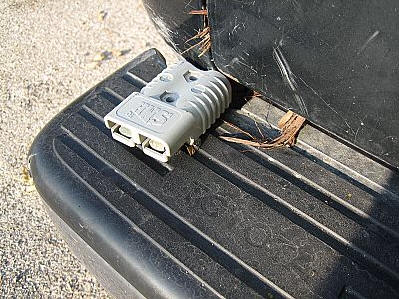
On the rear of the truck we also have a large metal bumper, and once again,
the Radar Receiver has been hidden in plain sight…
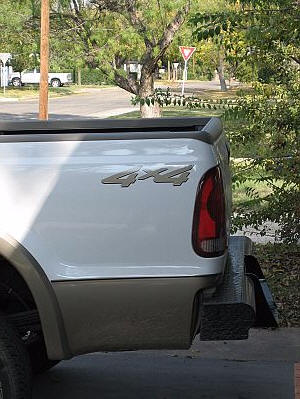
…this time mounted on the flat underside of the tow-plate.
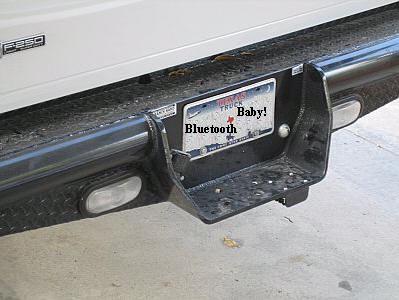
Here is another shot of the rear location…
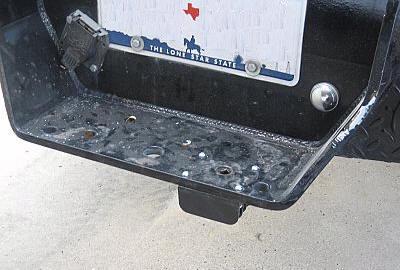
…and a close-up from the side. Except for the missing front "plug", the
Radar Receiver
could definitely pass as a winch component.
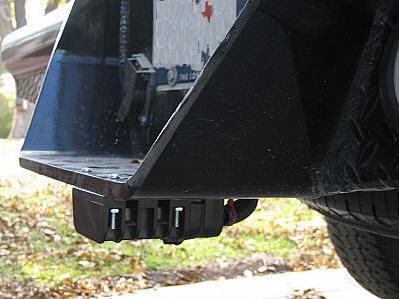
The wires seen coming from the rear of this receiver are tied into a power
line that only comes on when the truck’s ignition is on. The same was done with
the Radar Receiver on the front, as well as the Laser Defuser. This way the
system will immediately power on when the truck is turned on, and it will not
continue to run after the truck has been turned off.
Inside, the Interior Bluetooth Network Module was installed deep in the bowels
of the truck’s dashboard. The INM is the box with which the other components
communicate via Bluetooth. It is taking me a little bit of time to
get used to having an item which uses Bluetooth but that doesn’t have to be constantly
recharged like my mobile phone or BT headset!
Two blue LED lights were mounted on the top edge of the dash, where they
would be easily viewable. The one on the left indicates the front receiver, and
the one of the right is for the rear. It doesn’t much matter to me which is
which, as I immediately check my speed when either lights up. When the system is
turned on, both lights will glow indicating that they are fully operational.
These lights are wired directly into the INM, which is located less than a foot
away..
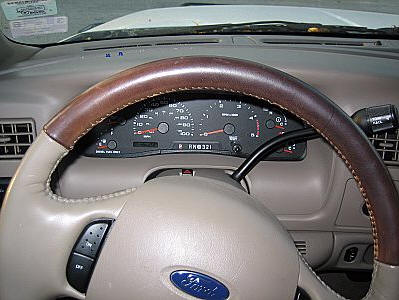
The location for mounting these LEDs is a matter of personal preference, some
might like to have them mounted directly in their dash cluster, amongst their
gauges. Others might like them mounted on the driver’s side crossbeam at eye
level, or wherever. Since so many vehicles have burglar alarm LEDs located on
their dash, we figured that these would most likely be dismissed as such by casual
passersby. At night time the blue LEDs are particularly brilliant, and even with the
CALIBRE’s sound muted there will be no question when the Radar is being
activated.
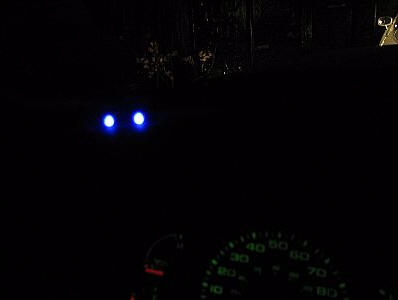
An alternative to the built in LEDs which do require drilling to install are
the small lighted Pods which K40 also offers. These are small lighted units that
also correspond to the front or rear radar, and which can also be mounted in a
convenient location for the driver’s viewing.
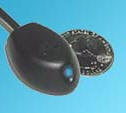
A digital sensing electronic air conditioner was offered as a factory option
on our truck,
but our truck doesn’t have it. The sensor’s small unutilized vent built into the dashboard made a perfect place
to hide the system’s speaker.
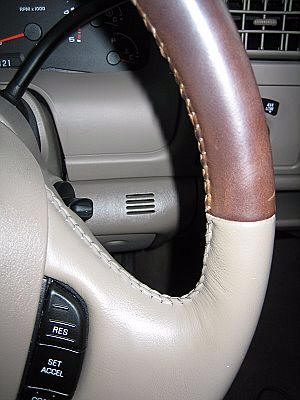
Not only does the CALIBRE use lights to indicate
when it is powering on or when radar is detected, it also uses sound. The user
has a choice of selecting a man’s voice to sound the alerts, or tones may be
used instead. These voice or tonal alerts may be adjusted to "high" "low" or
muted. When the system is muted and the system is alerted, the LEDs will flash
and the driver will still be notified with an urgent series of tones which will
quickly mute after a few seconds, so there is no fear of missing a notification.
If a true mute is desired (i.e. no sounds whatsoever), then the system must be
turned off.
I like hearing the man’s voice say "K40 ON" every time I start the truck, so
I leave it on voice mode all of the time.
In a side note: When the system was installed, there were no partnerships to
create between the BT units or switch codes to determine. The components were put in place, connected
to their power wires and when the truck was tuned on, the lights flashed
indicating that they were operational, and the "K40 ON" alert sounded indicating
that everything was ready to go! I wish that all BT partnerships were set up so
easily…
As the operator of the system, the only thing I have to fool with is
this little remote control, which measures 2" tall x 1.5" wide x 0.5"
thick. It uses a pair of AAA batteries,
and the first pair are included. Pressing the button at the bottom of each column allows the
user to cycle through that column’s choices. For instance, pressing the button on
the left turns the system on (if it’s off), sets the system to city or highway
mode, or turns everything off (if it’s on). The middle button switches the
system between tone or voice alerts, and the far right button adjusts the
systems volume from high, to low, to mute. Anytime a new setting is chosen, the
CALIBRE will respond with a verbal confirmation of the new selection.
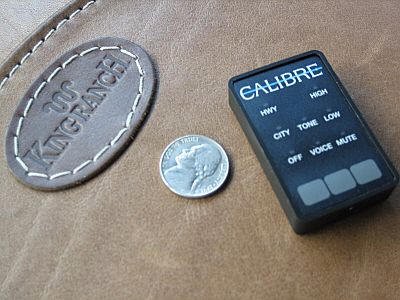
The remote comes with a piece of double sided tape for mounting, but I prefer
to keep mine in the cup holder cubby, where I also store the loose cigar lighter
and an eyeglass cleaning cloth.
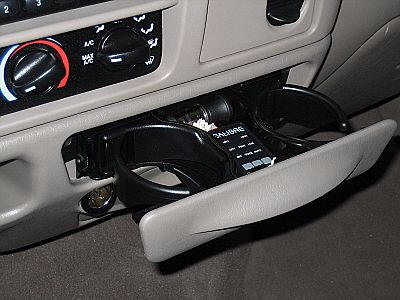
Okay, so that explained the system and its install, here is how my first
drive, On October 22 went…
When I turned the ignition on, because the system was left "On" the last time
the engine was stopped, everything started up again – beginning with a slightly
robotic man’s voice saying "K-FORTY…ON!" The two blue LEDs glowed,
giving me audible as well as visual confirmation that everything was working
as it should. Even though I was going to be driving in town, I set the
sensitivity to Highway. According to K40, this setting gives "full
sensitivity and warnings to all FCC allocated police radar bands and
technology."
Pulling out of the driveway, the system went quiet, because there
was nothing to cause an alert. Driving down Beauregard, past an Albertson’s
grocery store with an automatic door opener that will set off any radar detector, the
K40 was no exception. What’s so unique about the CALIBRE was that instead of
just hearing the typical radar detector trill going off with flashing lights and
an LED band notification, I got a verbal "FRONT X BAND" and a series of
progressively louder clicks for a few seconds as I drove by the front of the
store. The left side LED was also flashing blue. Right after passing, the voice
announced "REAR X BAND," as the right LED flashed blue and the speaker made a
few clicks while I left the area.
The first time I heard this, I got a small rush…it was so cool.
Traveling further down Beauregard, at the intersection where Sound Box Audio
sits across the street from Lee Jr. High, there is another area that always sets
off radar detectors. I am pretty sure that there is an extra strong X Band radar drone in the area
because it is a school zone. This time, I got the "FRONT X BAND" alert with a series of
progressively louder clicks along with the flashing LED. I also got a new
sound from the system – something similar to a small foghorn! After a second or
two of this, the system muted itself, but right after passing, the voice
announced "REAR X BAND" and there were a few more clicks as I left the area.
I should mention here that the High volume setting is pretty loud, enough so that I could easily hear the guy telling me when I
was being
zapped, even if I was listening to the stereo at a louder setting. If you don’t
listen to loud music while driving, then the Low setting should be sufficient.
The racket certainly reminds me to check my speed when it is school hours!
According to the K40 site, switching to the City mode "eliminates all
X-band warnings while also reducing other non-police radar signals." After
progressing a few blocks, I switched the remote to City, and drove back
by these same places. I was completely amazed that there was no warning as I
drove by the Jr. High. As I pulled near the Albertsons, I was treated to the
same silence. I don’t believe that I have ever had a radar detector that
actually managed to eliminate the noisy X Band while driving in town, and I like
it very much!
As I learned from the Speedlabs
site, there are no radar gun makers currently offering those that use X band,
although – don’t get me wrong – there are still X Band guns out there. According
to the Speedlabs site, "The FCC allows many other uses of X band aside from police radar guns.
Other uses include automatic door openers, burglar alarms, vehicle braking
systems, terrestrial microwave, etc." In other words, many of the false
signals given on radar detectors are because they receive X band. "Detector
makers now offer the elimination of X band reception as a feature on their radar
detectors eliminating annoying X band false alerts. In this mode, radar
detectors can’t detect X band."
So just as a reminder – when driving out of town, make sure the mode is
switched to "Highway", that way X Band will still be picked up. In the City
however, it is very nice to be able to block that noisy band.
According to the K40 site, the "CALIBRE detects all FCC allocated police frequencies including
X, K and Ka Superwide. Also, VG-2 Stealth Guard™ passively and actively conceals
your system from a police VG-2 Gun (radar detector detector)." When I first
read this, I was wondering what happened to Laser? See, I am used to knowing
that my radar detector has the capability to tell me that I have just been
zapped with Laser – even though I can’t honestly remember the last time that it
happened.
From what I have learned about Laser – none of it from firsthand experience,
mind you – in order to properly use a Laser gun, the policeman will aim it at
the flat area in the middle of the vehicle’s front – which generally happens to
be the license plate. By the time the plate has been zapped – even if a Laser
alarm has chirped – it is too late. The chirp you’ll hear is not the detector
picking up some other guy as he gets zapped – it is your car as it
gets zapped- and if speeding, there will be no chance to react. The reading is that quick and without
warning, unlike more traditional forms of Radar. For that reason, K40 offers
what they feel is a better solution. Instead of a Laser Detector, there
is an optional Bluetooth Laser Defuser which can be added to the CALIBRE
system. According to the K40 site, With the optional
Laser Defuser "you’ll deactivate police
laser capability by emitting a powerful infrared signal back to the gun at a
pulse rate the gun can’t understand. It actually deactivates the ability of the
laser gun to measure speed, while you receive audio & visual warnings that give
you the precious time you need to react and reduce your speed."
The Laser Defuser comes mounted at the top of a rigid black plastic license
plate frame and there are Defusers available for both the front and rear of the
vehicle. Depending on whether or not the intended vehicle can accept the frame,
the Laser Defuser may also be removed for separate installation, as is shown
here…
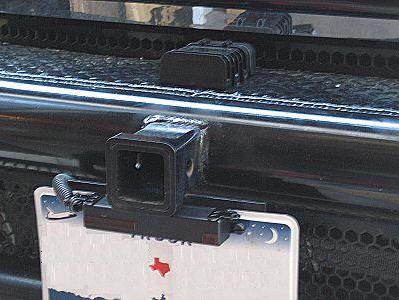
When the Laser Defuser is used, it integrates fully with the system, using
the existing LED notification lights. According to the CALIBRE manual, "When
your Laser Defuser, as part of your CALIBRE system, detects police laser, it
overrides all remote control settings and sounds an urgent laser alert tone,
accompanied by fully illuminated LED(s) that eventually flash and then diminish
as the threat passes."
Unfortunately, as I previously mentioned I have no real way to test the Laser
Defusers capabilities in my city. However I did learn from an officer that was
kind enough to grant me an interview that anything touching the sides or top of
a license plate in the State of Texas may get the driver a ticket in the state
of Texas – even a simple license plate frame without a Laser Defuser attached!
So for those of you in other states that are interested in the option, it might
be wise to be sure there are no prohibitive laws regarding license plate
obstruction before purchasing.
Over the past couple of weeks during which I have been using the CALIBRE, I
have had plenty of opportunities to experience its help during daily as
well as highway driving. I have been using the system exclusively, and the
notifications of upcoming radar seem to have always been given while I had plenty of time to slow down, if a quick
glance at the speedometer revealed I was traveling a little too fast.
I have grown a bit spoiled – yes, i can say it- by never having to remember to insert
or remove the detector from its portable bracket, and I have grown confident
that the CALIBRE is protecting me from radar because there have been quite a few
times when it has sounded its vocal alert, either to the front or from the rear
when I didn’t see any police vehicles. After a few moments of driving, the
police vehicle would become evident, either parked further along on the side of
the highway, driving in the opposite direction across the highway or driving in
the pack of cars ahead of me.
As confident as I have become, I did not want to fall into the trap of
believing in a product that might or might not be as reliable as I wanted to
think it was. Which is why I called a good friend of mine that works for a local
law enforcement agency and asked if he could find a a radar certified officer
that would be willing to help me perform a series of tests pitting the K40
CALIBRE against his gun. Surprisingly enough, my friend was able to find an
officer that had no objection to being interviewed and helping me perform a
battery of tests. Since I can’t say his name or give you the agency he worked
for, we shall henceforth call him "Officer Friendly" – because he certainly was.
Steve rode along this morning, after I got the call saying that the officer
could meet me. We met on a less traveled road with lots of curves, hills and
very little traffic. The officer parked his vehicle on the side of the road, and
we talked about some of the real world scenarios that might occur and which I
wanted to try testing for. He joked that he wasn’t giving us permission to
speed, and we told him that we didn’t plan to.
I told him that we were going to drive to the top of the hill, approximately
one mile away, then drive back and see how well we picked up his radar signal. I
thought that he would be leaving his radar gun on, so I was surprised when we
didn’t really get a signal until 0.7 miles away. However, once the CALIBRE
received the radar signal, it alerted us with a "FRONT K BAND" announcement.
We pulled up and talked to Officer Friendly for just a little bit, and this
time we decided to drive much further out. Steve put our Passport 8500 on the
windshield as we had decided to do a little bit of head-to-head testing. This
time, Officer Friendly left his radar detector on, so we drove slightly over two
miles hearing "REAR K BAND" over the CALIBRE. It should be noted that the
Passport stopped picking up the rear radar at approximately one mile out.
At 2.6 miles we stopped – confident that we were not going to hear the radar
trip again. We turned around, and had clocked 0.5 miles before we heard the
first "FRONT K BAND", the accompanying clicks…and then silence. This was
obviously our first warning – the point where had we been speeding down the
highway we would have needed to immediately slow down. A couple tenths of
a mile later, the detector came on strong with a "FRONT K BAND" warning and the
accompanying beeps then clicks. Soon after, the Passport began to make it’s
tonal alerts. At the top of the hill which you can see on the horizon in the
following picture, we were 1.1 miles away from the officer and both detectors
were clicking, as they had both entered Mute mode from constantly going off.
Once we pulled up to the officer, he told us that he had been able to clock our
speed from the top of the hill – but interestingly enough – he had been picking
us up for a little while longer.
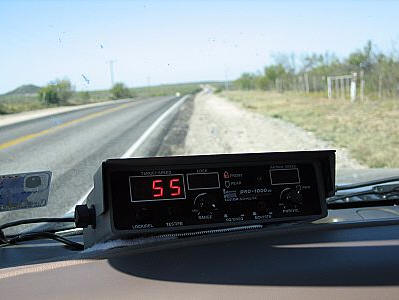
"I can’t drive…fifty-five!!!" (Thank goodness we no longer
have to!)
I always knew that radar used Doppler somehow, but I didn’t understand how it
worked. Officer Friendly explained that by using Doppler, even though he
couldn’t see the exact speed at which we were traveling because we were still
too far away for him to get a lock on us with his mounted gun, he could still
"hear" the revolutions of our engine. In other words, if we had gotten the
notice of an upcoming radar gun just past the crest of the hill – let’s say at
1.3 miles out, and if we had slammed on the brakes – he would have instantly
known that we had either been alerted by a passing motorist – or in our case
on such a deserted road, that we were using a radar detector because of the
sudden change in our engine’s sound over the Doppler. Wild huh?!
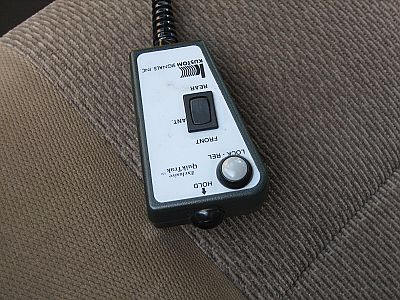
This is a photo of the remote which an officer uses when he has a mounted
radar gun in his vehicle. The Hold button on the top will be pressed, sending
out no radar signal whatsoever, until the officer sees an approaching vehicle
that he thinks might be speeding. Thumb off the Hold button – and it’s an
instant ticket if the officer is so inclined.
Once we had returned to Officer Friendly’s vehicle for the last time, we told
him how far back we had been able to receive his radar signal – both from the
front and from the rear. He acted quite impressed, especially since he had not
picked us up until just a little bit over a mile out. That’s when he wanted to
know what brand detector we were testing – K40! We stood on the side of
the road for about twenty minutes and discussed all of the things I have always
wanted to ask a radar operating officer, including subjects that were relevant
this review in particular.
First of all, I asked what band his detector was, and he confirmed that it
was K – just as the CALIBRE had stated.
I asked how he felt personally about radar detectors. His reply was that he
wanted his wife to have one, because it was a good tool to remind her not to
speed. He had no personal objection to people using radar detectors in the
least, and he said that seeing them on a vehicle’s windshield did not predispose
him to writing a ticket when he caught someone speeding. However, he said that
there are some officers which are basically offended by them. He
mentioned that one branch of Texas Law Enforcement sees them as having little
value other than for breaking the law.
We had a bit of a discussion after that about whether he felt a hidden radar
detector might keep one from getting a ticket, just because it wasn’t so obvious
to the stopping officer that the person might be predisposed to speeding. That’s
when Steve and I got the information about Doppler, meaning that if an officer
"hears" the sudden deceleration, even before he sees the vehicles actual speed,
that he will know there is probably a radar detector involved – whether or not
he ever actually sees one.
So that led to what can a person do to keep from getting a ticket once they
are actually pulled over. He was very candid about the fact that if a person
does not lie about their speeding, is respectful and is most of all – polite,
many times an officer will not write out a ticket, they will instead give either
a written or verbal warning. He said that we would be surprised at how many
people lie and become belligerent when dealing with a radar officer. He said
that there is even a name for what the officer becomes, "P O P O" for "pissed
off police officer"! Yikes, not something I want to create!
I asked him what he thought about radar detectors that claimed to be able to
tell you what side the signal was coming from and he just laughed. So I said,
it’s more important to know if the radar is ahead of you or if it is coming from
behind? And he said yes, because by the time the radar is on the side, it
doesn’t much matter anymore.
We started talking about Laser, which he said that he had seen up close and
in action. Evidently Laser is so spot on and single-minded that if it is aimed
at your vehicle then it will return a good reading. He also mentioned that on a
clear day with a good view of oncoming vehicles, a police officer would probably
know if his Laser reading was being tampered with – Officer Friendly felt that
Laser was that reliable and that dead on.
We talked a bit more about the CALIBRE, and he wanted to see its install. We
showed him the different components, which is when he pointed out that DPS might
take issue with the Defuser being mounted at the top of the license plate. He
was a bit shocked by the price for the entire system, which was when he asked if
K40 made any portable models. I was glad to be able to tell him that they did
and that I had reviewed that model also, and found it to be very good.
This morning’s test only confirmed what I had already decided, which is that
the K40 CALIBRE is an excellent radar detection unit. It is the ultimate in
convenience to be able to set the remote and then forget about it – until a
different setting is desired. The system is always ready once the ignition is
turned on, it is always working in the background even if muted, and while I
won’t go so far as to say that the system is infallible, it hasn’t failed me
yet. The CALIBRE definitely performs better than I had hoped for in regards to
distance when detecting upcoming or advancing from the rear radar detection, in
fact it easily outperformed my Passport.
Evidently I am not the only one pleased with the performance of the K40
CALIBRE system. Since the K40 CALIBRE was not available when
Speed Measurement Laboratories (SML)
performed their yearly Radar Detector Test
in June 2005, they conducted the same exact testing on the CALIBRE by itself
in October.
This quote was taken directly
from the final report given
to K40 after the CALIBRE was awarded SML’s
Performance Certification: "The
CALIBRE is unrivaled in ease of installation using Bluetooth
technology. We found its field performance equal to any premium remote radar
detector we have tested using our long standing testing criteria. It detected
all police radar guns up to seven times their normal targeting range. It
provided solid warnings and performance when confronted by all instant on and
constant on radar guns. It provides the performance of a premium dash mounted
radar detector while giving the security and convenience of a remotely installed
radar detector system."
According to the subsequent press
release, "To earn SML’s coveted
certification, a radar detector must correctly identify all radar bands at two
miles and react to the targeting in less than 1 second. While many competitive
detectors at SML’s annual test had difficulty with band identification and
providing timely notification to radar use, CALIBRE accurately and flawlessly
identified and warned of radar targeting on all three police radar bands at 2
miles as well as 1 ½ miles with an “immediacy of response” time averaging .08
seconds for all bands. CALIBRE’s response time rated with the best dash mount
radar detectors tested during SML’s annual test."
It’s all pretty heady stuff…but does it mean that the CALIBRE system is the
one for your particular application? Maybe.
Obviously the system has a few caveats. For one – it is very
expensive, there is just no way to get around that fact. But if you are on the
highway traveling a lot or if you have enough tickets on your history from
careless speeding, then you will find a way to pay for it – because the CALIBRE
will eventually pay for itself. Of course, if you the type that wants the latest
and greatest in your ride, if you are someone that owns a Ferrari or a Lambo,
then you probably won’t mind adding this top of the line system to your exotic
because it will keep the lines of your vehicle pristine while protecting you
from unnecessary tickets. Everything is relative.
The other thing to consider if price is not a problem is that this system may
not necessarily be the correct choice for someone that trades cars often. Since
it is a custom installed item, it would really be a pain to remove the various
components more than once. The good news is that leaving the CALIBRE in the
vehicle should add value to it when it is time to sell. Of course, if you are
someone that buys and sells Ferraris or Lambos on a regular basis, then this
will be a mere trifle.
The K40 CALIBRE comes with one of the best
guarantees I have ever seen, as it should! According to the K40 site, the
CALIBRE guarantee includes:
100% immunity from speeding tickets: We’ll pay any and all radar
speeding tickets you get for one year after purchase, excluding tickets issued
in school zones, construction zones and/or when DWI or DUI is involved. No
manufacturer of ordinary detectors dares offer this protection.
100% performance guarantee: If your new CALIBRE™ Radar
Detection System does not outperform any other radar detector you’ve owned,
return it within 30 days for full product credit.
100% protection against theft of the unit: If your CALIBRE
is ever stolen anywhere, under any circumstances, we’ll replace it at no cost to
you. Just provide us with proof of purchase and a copy of the police report that
was filed.
100% 3-year quality guarantee: We’re so sure of CALIBRE’s
quality that we’ve tripled our warranty! We’ll pay for any and all repairs or
replacement of defective parts for three years after purchase.
Price as tested: was approximately $1700 for the CALIBRE DL (Dual remote
radar) plus another $319 for the Bluetooth Laser Defuser, so approximately
$2020…! The CALIBRE system may be ordered in other configurations
however, and components may also be added at a later date.
According to Grant,
Suggested retail pricing, including installation,
is as follows:
CALIBRE
DL (dual remote radar with LEDs) $1699.95
CALIBRE DL-P (dual remote radar w/Pods) $1599.95
CALIBRE SL (single remote radar) $999.95
CALIBRE SL-P (single remote radar w/Pods) $899.95
LD5500 BT (Bluetooth Laser Defuser) $318.95
Wireless Charger iPhone Charging Station - 3-in-1 Magnetic MagSafe Charger Multiple Devices for Apple, 15W Fast Charging Foldable Travel Charging Pad for iPhone 17/16/15/14/13/12, AirPods, Apple Watch
48% OffWireless Charger 2Pack 6FT 15W Samsung Magnetic Wireless Charger Fast Charging Pad for Samsung Galaxy S25 Ultra/S24 FE/S23 Ultra/S22/S21/Z Google Pixel 9 8a 7a 8 7 Pro | Strong Magnet Technology
$19.99 (as of November 30, 2025 00:33 GMT -05:00 - More infoProduct prices and availability are accurate as of the date/time indicated and are subject to change. Any price and availability information displayed on [relevant Amazon Site(s), as applicable] at the time of purchase will apply to the purchase of this product.)Product Information
| Price: | |
| Manufacturer: | K40 Electronics |
| Requirements: |
|
| Pros: |
|
| Cons: |
|




Gadgeteer Comment Policy - Please read before commenting
I have an installed Calibre K40 DL-P and the remote has gone inoperative. How can I get a spare/replacement?
Thx,
George
Its very expensive not able to buy, is there any other alternative which is less cheaper or work in the same way.